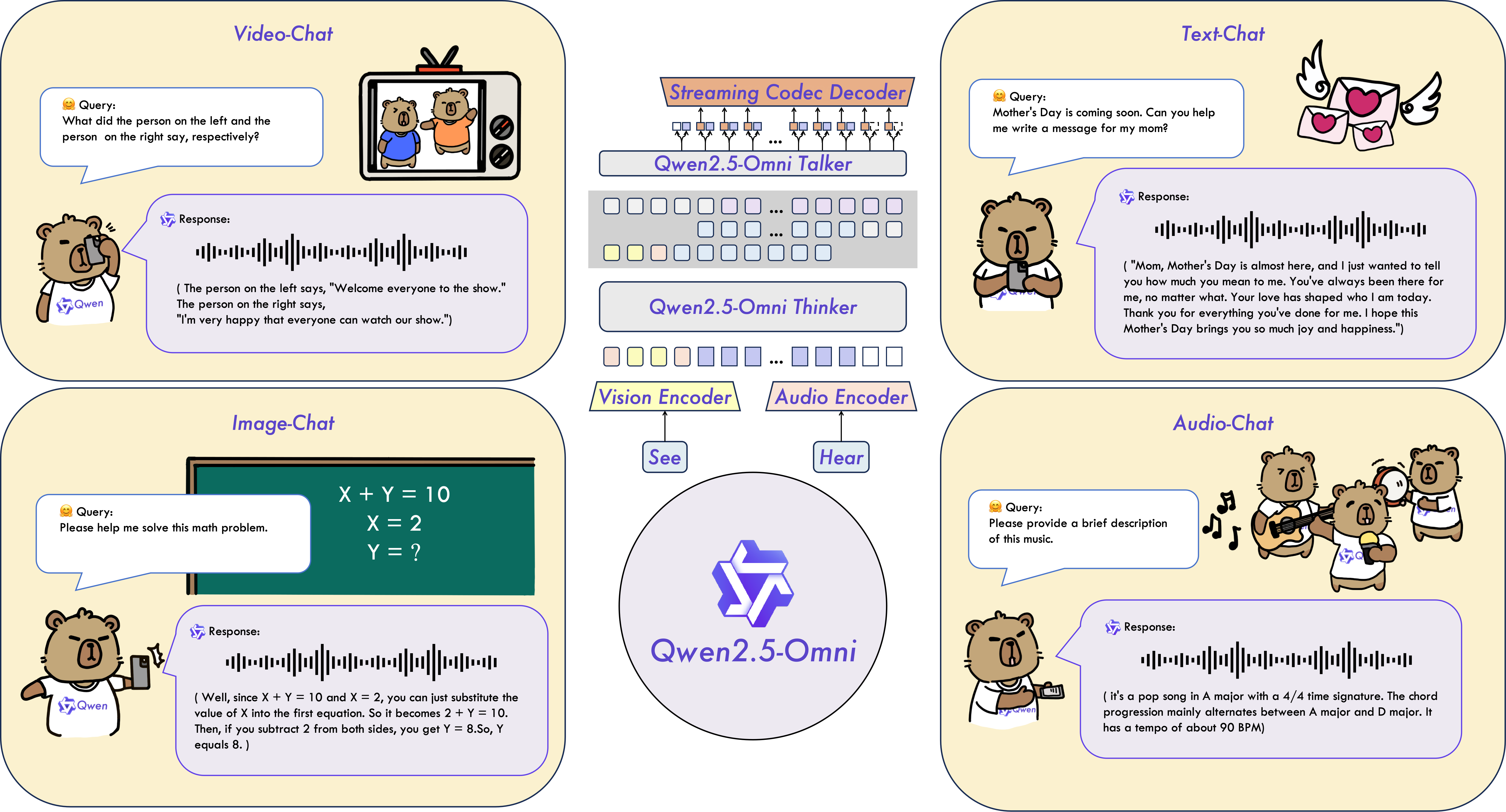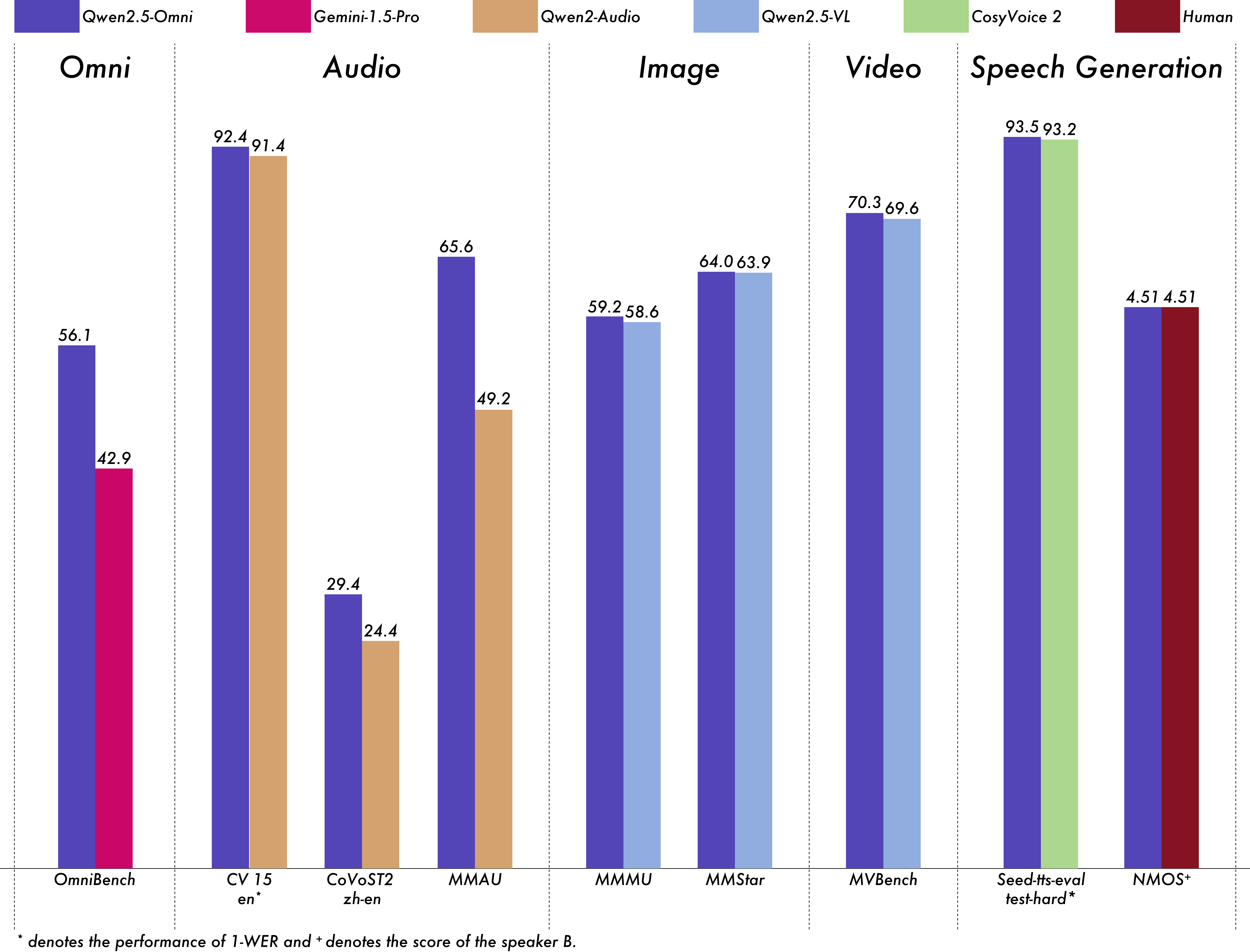
 ## OverView
### Introduction
Qwen2.5-Omni is an end-to-end multimodal model designed to perceive diverse modalities, including text, images, audio, and video, while simultaneously generating text and natural speech responses in a streaming manner.
## OverView
### Introduction
Qwen2.5-Omni is an end-to-end multimodal model designed to perceive diverse modalities, including text, images, audio, and video, while simultaneously generating text and natural speech responses in a streaming manner.

### Key Features * **Omni and Novel Architecture**: We propose Thinker-Talker architecture, an end-to-end multimodal model designed to perceive diverse modalities, including text, images, audio, and video, while simultaneously generating text and natural speech responses in a streaming manner. We prpose a novel position embedding, named TMRoPE (Time-aligned Multimodal RoPE), to synchronize the timestamps of video inputs with audio. * **Real-Time Voice and Video Chat**: Architecture Designed for fully real-time interactions, supporting chunked input and immediate output. * **Natural and Robust Speech Generation**: Surpassing many existing streaming and non-streaming alternatives, demonstrating superior robustness and naturalness in speech generation. * **Strong Performance Across Modalities**: Exhibiting exceptional performance across all modalities when benchmarked against similarly sized single-modality models. Qwen2.5-Omni outperforms the similarly sized Qwen2-Audio in audio capabilities and achieves comparable performance to Qwen2.5-VL-7B. * **Excellent End-to-End Speech Instruction Following**: Qwen2.5-Omni shows performance in end-to-end speech instruction following that rivals its effectiveness with text inputs, evidenced by benchmarks such as MMLU and GSM8K. ### Model Architecture

### Performance We conducted a comprehensive evaluation of Qwen2.5-Omni, which demonstrates strong performance across all modalities when compared to similarly sized single-modality models and closed-source models like Qwen2.5-VL-7B, Qwen2-Audio, and Gemini-1.5-pro. In tasks requiring the integration of multiple modalities, such as OmniBench, Qwen2.5-Omni achieves state-of-the-art performance. Furthermore, in single-modality tasks, it excels in areas including speech recognition (Common Voice), translation (CoVoST2), audio understanding (MMAU), image reasoning (MMMU, MMStar), video understanding (MVBench), and speech generation (Seed-tts-eval and subjective naturalness).

Multimodality -> Text
Datasets
Model
Performance
OmniBench
Speech | Sound Event | Music | AvgGemini-1.5-Pro
42.67%|42.26%|46.23%|42.91%
MIO-Instruct
36.96%|33.58%|11.32%|33.80%
AnyGPT (7B)
17.77%|20.75%|13.21%|18.04%
video-SALMONN
34.11%|31.70%|56.60%|35.64%
UnifiedIO2-xlarge
39.56%|36.98%|29.25%|38.00%
UnifiedIO2-xxlarge
34.24%|36.98%|24.53%|33.98%
MiniCPM-o
-|-|-|40.50%
Baichuan-Omni-1.5
-|-|-|42.90%
Qwen2.5-Omni-7B
55.25%|60.00%|52.83%|56.13%
Audio -> Text
Datasets
Model
Performance
ASR
Librispeech
dev-clean | dev other | test-clean | test-otherSALMONN
-|-|2.1|4.9
SpeechVerse
-|-|2.1|4.4
Whisper-large-v3
-|-|1.8|3.6
Llama-3-8B
-|-|-|3.4
Llama-3-70B
-|-|-|3.1
Seed-ASR-Multilingual
-|-|1.6|2.8
MiniCPM-o
-|-|1.7|-
MinMo
-|-|1.7|3.9
Qwen-Audio
1.8|4.0|2.0|4.2
Qwen2-Audio
1.3|3.4|1.6|3.6
Qwen2.5-Omni-7B
1.6|3.5|1.8|3.4
Common Voice 15
en | zh | yue | frWhisper-large-v3
9.3|12.8|10.9|10.8
MinMo
7.9|6.3|6.4|8.5
Qwen2-Audio
8.6|6.9|5.9|9.6
Qwen2.5-Omni-7B
7.6|5.2|7.3|7.5
Fleurs
zh | enWhisper-large-v3
7.7|4.1
Seed-ASR-Multilingual
-|3.4
Megrez-3B-Omni
10.8|-
MiniCPM-o
4.4|-
MinMo
3.0|3.8
Qwen2-Audio
7.5|-
Qwen2.5-Omni-7B
3.0|4.1
Wenetspeech
test-net | test-meetingSeed-ASR-Chinese
4.7|5.7
Megrez-3B-Omni
-|16.4
MiniCPM-o
6.9|-
MinMo
6.8|7.4
Qwen2.5-Omni-7B
5.9|7.7
Voxpopuli-V1.0-en
Llama-3-8B
6.2
Llama-3-70B
5.7
Qwen2.5-Omni-7B
5.8
S2TT
CoVoST2
en-de | de-en | en-zh | zh-enSALMONN
18.6|-|33.1|-
SpeechLLaMA
-|27.1|-|12.3
BLSP
14.1|-|-|-
MiniCPM-o
-|-|48.2|27.2
MinMo
-|39.9|46.7|26.0
Qwen-Audio
25.1|33.9|41.5|15.7
Qwen2-Audio
29.9|35.2|45.2|24.4
Qwen2.5-Omni-7B
30.2|37.7|41.4|29.4
SER
Meld
WavLM-large
0.542
MiniCPM-o
0.524
Qwen-Audio
0.557
Qwen2-Audio
0.553
Qwen2.5-Omni-7B
0.570
VSC
VocalSound
CLAP
0.495
Pengi
0.604
Qwen-Audio
0.929
Qwen2-Audio
0.939
Qwen2.5-Omni-7B
0.939
Music
GiantSteps Tempo
Llark-7B
0.86
Qwen2.5-Omni-7B
0.88
MusicCaps
LP-MusicCaps
0.291|0.149|0.089|0.061|0.129|0.130
Qwen2.5-Omni-7B
0.328|0.162|0.090|0.055|0.127|0.225
Audio Reasoning
MMAU
Sound | Music | Speech | AvgGemini-Pro-V1.5
56.75|49.40|58.55|54.90
Qwen2-Audio
54.95|50.98|42.04|49.20
Qwen2.5-Omni-7B
67.87|69.16|59.76|65.60
Voice Chatting
VoiceBench
AlpacaEval | CommonEval | SD-QA | MMSUUltravox-v0.4.1-LLaMA-3.1-8B
4.55|3.90|53.35|47.17
MERaLiON
4.50|3.77|55.06|34.95
Megrez-3B-Omni
3.50|2.95|25.95|27.03
Lyra-Base
3.85|3.50|38.25|49.74
MiniCPM-o
4.42|4.15|50.72|54.78
Baichuan-Omni-1.5
4.50|4.05|43.40|57.25
Qwen2-Audio
3.74|3.43|35.71|35.72
Qwen2.5-Omni-7B
4.49|3.93|55.71|61.32
VoiceBench
OpenBookQA | IFEval | AdvBench | AvgUltravox-v0.4.1-LLaMA-3.1-8B
65.27|66.88|98.46|71.45
MERaLiON
27.23|62.93|94.81|62.91
Megrez-3B-Omni
28.35|25.71|87.69|46.25
Lyra-Base
72.75|36.28|59.62|57.66
MiniCPM-o
78.02|49.25|97.69|71.69
Baichuan-Omni-1.5
74.51|54.54|97.31|71.14
Qwen2-Audio
49.45|26.33|96.73|55.35
Qwen2.5-Omni-7B
81.10|52.87|99.42|74.12
Image -> Text
| Dataset | Qwen2.5-Omni-7B | Other Best | Qwen2.5-VL-7B | GPT-4o-mini |
|--------------------------------|--------------|------------|---------------|-------------|
| MMMUval | 59.2 | 53.9 | 58.6 | **60.0** |
| MMMU-Prooverall | 36.6 | - | **38.3** | 37.6 |
| MathVistatestmini | 67.9 | **71.9** | 68.2 | 52.5 |
| MathVisionfull | 25.0 | 23.1 | **25.1** | - |
| MMBench-V1.1-ENtest | 81.8 | 80.5 | **82.6** | 76.0 |
| MMVetturbo | 66.8 | **67.5** | 67.1 | 66.9 |
| MMStar | **64.0** | **64.0** | 63.9 | 54.8 |
| MMEsum | 2340 | **2372** | 2347 | 2003 |
| MuirBench | 59.2 | - | **59.2** | - |
| CRPErelation | **76.5** | - | 76.4 | - |
| RealWorldQAavg | 70.3 | **71.9** | 68.5 | - |
| MME-RealWorlden | **61.6** | - | 57.4 | - |
| MM-MT-Bench | 6.0 | - | **6.3** | - |
| AI2D | 83.2 | **85.8** | 83.9 | - |
| TextVQAval | 84.4 | 83.2 | **84.9** | - |
| DocVQAtest | 95.2 | 93.5 | **95.7** | - |
| ChartQAtest Avg | 85.3 | 84.9 | **87.3** | - |
| OCRBench_V2en | **57.8** | - | 56.3 | - |
| Dataset | Qwen2.5-Omni-7B | Qwen2.5-VL-7B | Grounding DINO | Gemini 1.5 Pro |
|--------------------------|--------------|---------------|----------------|----------------|
| Refcocoval | 90.5 | 90.0 | **90.6** | 73.2 |
| RefcocotextA | **93.5** | 92.5 | 93.2 | 72.9 |
| RefcocotextB | 86.6 | 85.4 | **88.2** | 74.6 |
| Refcoco+val | 85.4 | 84.2 | **88.2** | 62.5 |
| Refcoco+textA | **91.0** | 89.1 | 89.0 | 63.9 |
| Refcoco+textB | **79.3** | 76.9 | 75.9 | 65.0 |
| Refcocog+val | **87.4** | 87.2 | 86.1 | 75.2 |
| Refcocog+test | **87.9** | 87.2 | 87.0 | 76.2 |
| ODinW | 42.4 | 37.3 | **55.0** | 36.7 |
| PointGrounding | 66.5 | **67.3** | - | - |
Video(without audio) -> Text
| Dataset | Qwen2.5-Omni-7B | Other Best | Qwen2.5-VL-7B | GPT-4o-mini |
|-----------------------------|--------------|------------|---------------|-------------|
| Video-MMEw/o sub | 64.3 | 63.9 | **65.1** | 64.8 |
| Video-MMEw sub | **72.4** | 67.9 | 71.6 | - |
| MVBench | **70.3** | 67.2 | 69.6 | - |
| EgoSchematest | **68.6** | 63.2 | 65.0 | - |
Zero-shot Speech Generation
Datasets
Model
Performance
Content Consistency
SEED
test-zh | test-en | test-hard Seed-TTS_ICL
1.11 | 2.24 | 7.58
Seed-TTS_RL
1.00 | 1.94 | 6.42
MaskGCT
2.27 | 2.62 | 10.27
E2_TTS
1.97 | 2.19 | -
F5-TTS
1.56 | 1.83 | 8.67
CosyVoice 2
1.45 | 2.57 | 6.83
CosyVoice 2-S
1.45 | 2.38 | 8.08
Qwen2.5-Omni-7B_ICL
1.70 | 2.72 | 7.97
Qwen2.5-Omni-7B_RL
1.42 | 2.32 | 6.54
Speaker Similarity
SEED
test-zh | test-en | test-hard Seed-TTS_ICL
0.796 | 0.762 | 0.776
Seed-TTS_RL
0.801 | 0.766 | 0.782
MaskGCT
0.774 | 0.714 | 0.748
E2_TTS
0.730 | 0.710 | -
F5-TTS
0.741 | 0.647 | 0.713
CosyVoice 2
0.748 | 0.652 | 0.724
CosyVoice 2-S
0.753 | 0.654 | 0.732
Qwen2.5-Omni-7B_ICL
0.752 | 0.632 | 0.747
Qwen2.5-Omni-7B_RL
0.754 | 0.641 | 0.752
Text -> Text
| Dataset | Qwen2.5-Omni-7B | Qwen2.5-7B | Qwen2-7B | Llama3.1-8B | Gemma2-9B |
|-----------------------------------|-----------|------------|----------|-------------|-----------|
| MMLU-Pro | 47.0 | **56.3** | 44.1 | 48.3 | 52.1 |
| MMLU-redux | 71.0 | **75.4** | 67.3 | 67.2 | 72.8 |
| LiveBench0831 | 29.6 | **35.9** | 29.2 | 26.7 | 30.6 |
| GPQA | 30.8 | **36.4** | 34.3 | 32.8 | 32.8 |
| MATH | 71.5 | **75.5** | 52.9 | 51.9 | 44.3 |
| GSM8K | 88.7 | **91.6** | 85.7 | 84.5 | 76.7 |
| HumanEval | 78.7 | **84.8** | 79.9 | 72.6 | 68.9 |
| MBPP | 73.2 | **79.2** | 67.2 | 69.6 | 74.9 |
| MultiPL-E | 65.8 | **70.4** | 59.1 | 50.7 | 53.4 |
| LiveCodeBench2305-2409 | 24.6 | **28.7** | 23.9 | 8.3 | 18.9 |
Minimum GPU memory requirements
| Precision | 15(s) Video | 30(s) Video | 60(s) Video |
|-----------| ------------- | --------- | -------------- |
| FP32 | 93.56 GB | Not Recommend | Not Recommend |
| BF16 | 31.11 GB | 41.85 GB | 60.19 GB |
Note: The table above presents the theoretical minimum memory requirements for inference with `transformers` and `BF16` is test with `attn_implementation="flash_attention_2"`; however, in practice, the actual memory usage is typically at least 1.2 times higher. For more information, see the linked resource [here](https://huggingface.co/docs/accelerate/main/en/usage_guides/model_size_estimator).
Video ULR resource usage
Video URL compatibility largely depends on the third-party library version. The details are in the table below. Change the backend by `FORCE_QWENVL_VIDEO_READER=torchvision` or `FORCE_QWENVL_VIDEO_READER=decord` if you prefer not to use the default one.
| Backend | HTTP | HTTPS |
|-------------|------|-------|
| torchvision >= 0.19.0 | ✅ | ✅ |
| torchvision < 0.19.0 | ❌ | ❌ |
| decord | ✅ | ❌ |
Batch inference
The model can batch inputs composed of mixed samples of various types such as text, images, audio and videos as input when `return_audio=False` is set. Here is an example.
```python
# Sample messages for batch inference
# Conversation with video only
conversation1 = [
{
"role": "system",
"content": "You are Qwen, a virtual human developed by the Qwen Team, Alibaba Group, capable of perceiving auditory and visual inputs, as well as generating text and speech.",
},
{
"role": "user",
"content": [
{"type": "video", "video": "/path/to/video.mp4"},
]
}
]
# Conversation with audio only
conversation2 = [
{
"role": "system",
"content": "You are Qwen, a virtual human developed by the Qwen Team, Alibaba Group, capable of perceiving auditory and visual inputs, as well as generating text and speech.",
},
{
"role": "user",
"content": [
{"type": "audio", "audio": "/path/to/audio.wav"},
]
}
]
# Conversation with pure text
conversation3 = [
{
"role": "system",
"content": "You are Qwen, a virtual human developed by the Qwen Team, Alibaba Group, capable of perceiving auditory and visual inputs, as well as generating text and speech.",
},
{
"role": "user",
"content": "who are you?"
}
]
# Conversation with mixed media
conversation4 = [
{
"role": "system",
"content": "You are Qwen, a virtual human developed by the Qwen Team, Alibaba Group, capable of perceiving auditory and visual inputs, as well as generating text and speech.",
},
{
"role": "user",
"content": [
{"type": "image", "image": "/path/to/image.jpg"},
{"type": "video", "video": "/path/to/video.mp4"},
{"type": "audio", "audio": "/path/to/audio.wav"},
{"type": "text", "text": "What are the elements can you see and hear in these medias?"},
],
}
]
# Combine messages for batch processing
conversations = [conversation1, conversation2, conversation3, conversation4]
# Preparation for batch inference
text = processor.apply_chat_template(conversations, add_generation_prompt=True, tokenize=False)
audios, images, videos = process_mm_info(conversations, use_audio_in_video=True)
inputs = processor(text=text, audios=audios, images=images, videos=videos, return_tensors="pt", padding=True)
inputs = inputs.to(model.device).to(model.dtype)
# Batch Inference
text_ids = model.generate(**inputs, use_audio_in_video=True, return_audio=False)
text = processor.batch_decode(text_ids, skip_special_tokens=True, clean_up_tokenization_spaces=False)
print(text)
```